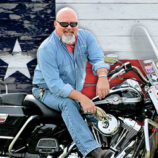The weekend after Memorial Day, a column by Garrison Keillor entitled “Disturbed by the Roar of Hollow Patriotism” appeared in newspapers nationwide. In what can best be described as a semi-coherent and hate-tinged screed, Garrison set his teeth into two seemingly unrelated topics simultaneously, and when he had finished gnawing, succeeded in exposing to his readers two troubling aspects of his woebegone psyche, those being: 1) his deep-seated contempt for bikers in general, and the bikers of Rolling Thunder in particular, and, 2) his swooning schoolgirl infatuation with 19th century impressionist painting.
The setup for this awkward breast-baring was Garrison’s decision to visit the National Gallery of Art on the Sunday of Memorial Day weekend, and his pique at having to wait for a break in the Rolling Thunder procession in order to cross a street. So irritating was this inconvenience, that Garrison needed some payback and proceeded to cut loose with a litany of abuse in his column, starting with the declaration that, “A patriotic bike rally is sort of like a patriotic toilet-papering or patriotic graffiti: the patriotism somehow gets lost in the sheer irritation of the thing.” We next learn that in Garrison’s view the only proper observance of the holiday is silent reflection on cinematic mental images of D-Day, and thus that, “You don’t quite see the connection between that and those fat old men with ponytails on Harleys.” He has an idea of what to do with the fat old men, though, suggesting that we “airlift these gentlemen to Baghdad to show their support of troops in a more tangible way.”
OK, we get it, Garrison. You don’t like bikers.
But Garrison’s not finished braying yet. He goes on to characterize the bikers as “grown men playing soldier, making a great hullaballoo without exposing themselves to danger, other than getting drunk and falling off a bike,” and sums up Rolling Thunder tidily as “full of bluster, giving off noxious fumes, and when they leave town, nobody misses them.”
It hardly needs saying that these bizarre and, frankly, juvenile insults are unhinged from reality, and that an overwhelming number of the Rolling Thunder participants are, in fact, current or former servicemen and women, their families, and the families of deceased combatants. They don’t need to “play” soldier. It also hardly needs saying that the principal organizations responsible for the tribute, both Rolling Thunder Inc. and The Run For The Wall, are selfless in their mission to honor the deceased, keep the fate of POWs and MIAs in the forefront of public consciousness, and advocate for the rights and welfare of both veterans and current service personnel alike.
Equally galling in all of this is the fact that in leveling his broadside against the demonstrative patriotism he so clearly associates exclusively with right wing politics, Garrison doesn’t just blast the right wing patriots, but succeeds also in blasting those of us who are left-wing patriots or patriots of no particular wing who remain, all the same, profoundly grateful for the sacrifice of our countrymen irrespective of whatever wrongheaded politics put them in harm’s way.
It’s troubling that Garrison is either ignorant of these truths or, worse, knows these things but chooses to overlook them in his zeal to make what we can only assume is some kind of a point. It’s surely beneath him, you’d like to think, but it’s in the intervening passages between the insults when he’s attempting to pithily contrast his irritation at bikers with his rapture in viewing the paintings of Renoir, Monet and Cassat that it becomes sadly apparent that Garrison’s lost it. He’s lost his familiar humor, charm, and homey wistfulness—as well, I might add, as his likability, lucidity and relevance.
Most of that verbiage is devoted to a tedious recounting of his personal response to “The Boating Party,” a painting by Mary Cassat, and while I have nothing against Mary Cassat—to the contrary, she’s my favorite expatriate American proto-feminist impressionist, too—I find myself unable to grasp any meaningful or even rational connection between Garrison’s gallery experience and the spectacle of hundreds of thousands of his fellow Americans paying solemn tribute to the country’s war dead on a weekend set aside for doing just that.
Apparently Garrison can’t either. When the time comes to tie his whole rambling diatribe together convincingly and deliver up some summation of substance, he punts and goes for another long gaze at the painting and at his navel, and serves up a scoop of fatuous prose worthy of Bulwer-Lytton, to wit: “I am the boatman and maybe you are, too—it is quiet on the water, we lean on the oars, and we are suspended in time, united with every other man, woman and child who ever voyaged afar.”
And meanwhile, outside the calm refuge of the gallery are a multitude of men, women and children who have voyaged from afar, coming from every state in the union to be in Washington for the sole purpose of paying their respects to all of the men and women whose own voyages were cut short in service to their country. It’s quiet where they are, too.
It’s all right here in the diaries.


















